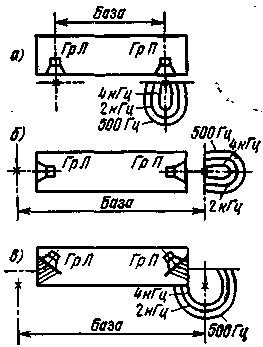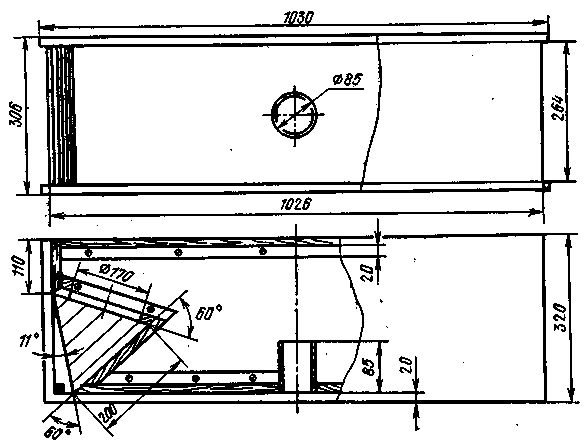
|
|
ENCYCLOPEDIA OF RADIO ELECTRONICS AND ELECTRICAL ENGINEERING Monoblock stereo loudspeaker. Encyclopedia of radio electronics and electrical engineering
Encyclopedia of radio electronics and electrical engineering / Speakers We have long been accustomed to the fact that stereo installations have at least two spaced loudspeakers. As noted, four or more speakers are recommended to further enhance the sound. But, as practice shows, the presence of several spaced loudspeakers clutters up the living space, entangles it with wires, and creates some inconvenience. Therefore, radio amateurs and radio designers have long had a desire to create monoblock stereo loudspeakers, i.e. such designs, and in which the heads of both channels of the stereo system would be placed in one housing. It should be noted that monoblock stereo loudspeakers have existed for a long time in the form of so-called console radios and high-class radio combines. Such installations are sometimes larger than the old chests of drawers. Attempts to reduce the size of monoblock stereo loudspeakers face the difficulty of maintaining the size of the stereo base. The fact is that the stereo effect appears when the distance between the speakers of the left and right channels is 1,5-2,5 m, and the listener himself is at an equal distance in front of the speakers (about 1-3 m). When placing the heads of both loudspeakers in the same plane, the base of the stereo system is approximately equal to the distance between the centers of the cones of the heads of different channels. Therefore, by reducing the size of the case, we thereby reduce the base of the stereo system and reduce the manifestation of the stereo effect. Abroad, there are several systems of stereo loudspeakers with a reduced base. But before proceeding to the consideration of the construction itself, let us dwell briefly on the principle of its operation, illustrated in Fig. 1, a-c.
Figure 1a schematically shows the placement of the heads in a conventional monoblock loudspeaker of a console radio. The base of the system, determined by the distance between the phase centers of the radiation of the heads of the left and right channels, indicated by two asterisks, is somewhat less than the length of the loudspeaker. With such an arrangement of heads, the main direction of radiation at signal frequencies coincides with the direction towards the listener. To obtain a base of at least 1,5 m, the body length should be about 2 m. If this size is reduced to 1 m, then the stereo effect will appear only in the immediate vicinity of the loudspeaker, at a distance of about 1 m. This is already inconvenient. The base can be expanded if the heads are placed on the side walls of the loudspeaker housing, as shown in Fig. 1b. But at the same time, the main direction of radiation to the midrange, and especially at higher frequencies, will be oriented perpendicular to the direction to the listener. It is obvious that a sound depleted of medium and high frequencies cannot give the listener much pleasure. To increase the base of a monoblock stereo loudspeaker, on the one hand, and to maintain a sufficiently powerful radiation at medium and higher frequencies towards the listener, on the other hand, it is necessary to place the heads of the left and right channels in the end walls and partially deploy them in a horizontal plane at a certain angle to the side listener. In most cases, this is exactly what many designers do. Such loudspeakers differ only in the angles of rotation of the heads and the geometric dimensions of the case. But Fig. 1c shows a longitudinal section of a monoblock stereo loudspeaker, in which, in addition to turning the heads, an improvement has been introduced that significantly expands the base while maintaining the radiation directivity towards the listener in a wide frequency band. The essence of the innovation lies in the fact that acoustic waveguides are placed in front of the diffusers of the heads - metal plates that change the direction of propagation of the sound reproduced by the heads away from the listener. So there are two factors involved here. First, turning the head towards the listener improves the radiation pattern towards the listener. Second, deflecting the sound away from the listener increases the base of the system. With a well-defined ratio of the angles of rotation of the heads and the directivity of the acoustic waveguides, it is possible to achieve an expansion of the base and maintain the required directionality of the sound. In this loudspeaker, with a loudspeaker cabinet length of 750 mm, a base of about 1,5 m can be obtained. Figure 2 shows sketches of a general view of the front panel and an internal view of an amateur loudspeaker, in which the principle of constructing a monoblock stereo loudspeaker described above is implemented. The installation of two heads of different channels in one housing creates the conditions for improving the acoustic output at low frequencies, both due to the effect of a group radiator, and through the adoption of additional measures - the use of a phase inverter with a pipe shown in Fig. 2. A cardboard tube with a diameter and length of 86 mm improves the uniformity of the amplitude-frequency characteristic of the installation in the low-frequency region, and expands the bandwidth.
The effectiveness of the manifestations of the stereo effect of an amateur monoblock loudspeaker according to the sketches in Fig. 2 largely depends on the accuracy of the installation of the heads in the case and the uniformity of the placement of the waveguide plates relative to each other. The loudspeaker enclosure is made of plywood or chipboard 20 mm thick. The external dimensions of the case are 306X X320X1030 mm, i.e. the loudspeaker case in its shape and dimensions resembles a wall-mounted bookshelf. To ensure the correct repetition of the design, its author recommends the following manufacturing sequence. On a sheet of graph paper, a life-size contour of the longitudinal section of the future loudspeaker housing is built according to the dimensions of Fig. 2. Further, at a distance of 110 mm from the edge of the rear wall, a line is drawn that goes at an angle of 11 ° to the contour of the side wall. From the point of intersection of this line with the contour of the outer contour of the front panel at an angle of 60 ° to the first drawn line, a second line 200 mm long is drawn. Then a third line is drawn from the end of the second line at an angle of 60e to it. Under the condition of precise constructions, the third line should pass through the point from which the geometric constructions were started. In plan, the lines drawn, intersecting, should form an equilateral triangle with sides of 200 mm. Then the contour of the inner contour of the body is built, the holes for the head are marked. Similar constructions are carried out on the second end of the loudspeaker housing. Acoustic waveguide plates are made of flat sheet duralumin 1,5 mm thick and 266 mm high. When installing the top and bottom covers in the grooves, it is important to ensure their mutual parallel position and the equality of the distances between them. The plates should be parallel to the blank wall set at an angle to the front panel. The heads are installed on the walls with a circular cutout with a diameter equal to the diameter of the diffuser along the border of its gluing with the diffuser holder, behind the corrugations. The inner surface of the body is covered with a layer of mineral wool 50-70 mm thick. The author of the design also used an additional wall of wool between each head and the total volume of air in the loudspeaker case. Such measures make it possible to reduce the influence of sound reflections inside the case and to exclude the direct impact of the heads on each other. When repeating the design, it is recommended to use domestic broadband heads of increased and normal sensitivity, for example, type 4GD-36, having a voice coil resistance of 4 and 8 ohms. In this case, it is necessary to clarify the mounting dimensions and the diameter of the hole for the diffuser opening. For decorative design of the case, a thin radio fabric is used, which is covered with both end walls and the front panel (in one piece). The top and bottom covers are veneered or covered with an imitation film. According to the author of the design, the quality of the loudspeaker is high. With a hull length of about 1 m, the base is more than 1,7 m, i.e. given. a monoblock loudspeaker is equivalent in its properties to two loudspeakers separated from each other by a distance of about 2 m. To this it must be added that the loudspeaker can be hung on the wall, put on it, like on a bookshelf, various books and magazines. The quality of the loudspeaker will not deteriorate from this. Literature:
Publication: N. Bolshakov, rf.atnn.ru
Artificial leather for touch emulation
15.04.2024 Petgugu Global cat litter
15.04.2024 The attractiveness of caring men
14.04.2024
▪ ClearForce technology for pressure sensitivity of displays ▪ Hydrogen is the cheapest way to cut emissions ▪ Bees have emotions and mood swings ▪ Next Generation Solid State Drives from Toshiba
▪ Modeling section of the site. Selection of articles ▪ article Spinning for the model. Tips for a modeler ▪ article How did the wife of Louis XIV ride a sleigh in the summer? Detailed answer ▪ article Tatar proverbs and sayings. Large selection
Home page | Library | Articles | Website map | Site Reviews www.diagram.com.ua |






 Arabic
Arabic Bengali
Bengali Chinese
Chinese English
English French
French German
German Hebrew
Hebrew Hindi
Hindi Italian
Italian Japanese
Japanese Korean
Korean Malay
Malay Polish
Polish Portuguese
Portuguese Spanish
Spanish Turkish
Turkish Ukrainian
Ukrainian Vietnamese
Vietnamese


 Leave your comment on this article:
Leave your comment on this article: